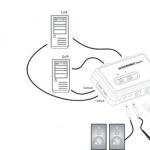
To protect your land from animals (and not only), you can use an electric fence, which is made of wire or metal mesh stretched on insulating poles, it does not come into contact with the ground, but is connected to a grounded source of high-voltage impulses. In relation to the life of animals or people, this does not pose a danger, but it gives a rather unpleasant and frightening sensation.
In order for the electric fence to perform only a deterrent function, it is necessary to apply short high-voltage pulses to it, which are repeated at some interval.
The pulse generator can be made according to the scheme shown in Fig. 1. At the heart of the generator is a ready-made high-voltage transformer, its role can be played by an ignition coil taken from a passenger car. The ignition coil is a transformer with a low-resistance primary and a high-resistance secondary coil. When there is a ripple of current in the primary, high voltage pulses are formed on the secondary. In the car they go to the spark plugs, but here they go to the fence.
For the circuit to work, it is necessary to apply a pulsed voltage to the primary, which consists of interrupted bursts of pulses audio frequency, they repeat after a certain period of time. The circuit for recreating these pulses is made on three integrated timers of the 555 brand.

On the basis of timers A1 and AZ, generators of infrasonic and sound vibrations, respectively, were made. Based on the A2 timer - a single vibrator.
The current to the primary of the ignition coil T1 goes through the key on the field-effect transistor LG 1. In order for a high voltage to form in the secondary of T1, it is necessary that the current pulsate in the primary. Based on the AZ timer, a sound pulse generator was made. When it works, audio frequency pulses from its output (pin 3) go to the gate of the transistor. As a result, a pulsating current is formed on the primary T1, it induces a high AC voltage on the secondary.
The sound pulse generator is controlled by the level at pin 4 AZ. In order for the generator to work on this output, a logic-one voltage is needed. At a logical zero, the generator is blocked and its output is set to a logical zero.
On the basis of the A1 timer, an infrasonic generator was made, it generates pulses. The frequency of these pulses can be adjusted using a variable resistor K1. The frequency of high-voltage pulses to your fence depends on this generator. Pulses from pin 3 A1 go to pin 2 A2.
Printed circuit board

Based on the A2 timer, a single vibrator circuit is made. Upon the arrival of each of the pulses at pin 2, it generates one pulse of a given duration, you can adjust it using a variable resistor K4. This pulse signal goes through resistor B10 to the gate of a powerful key field-effect transistor UT1A in its drain circuit, the primary of a standard automobile ignition coil T1 is connected. Almost any ignition coil can be used. It is better to use a coil from cars with a "contact" ignition system. For example, from the "Zhiguli" VAZ - 2101 or 2106, "Moskvich" 412 or 2140.
The basis of the article is taken from the magazine "RADIOCONSTRUCTOR"
An electric shepherd or an electric fence is a kind of device that is used for various purposes. It helps to protect animals or defend against animals. The design of the device from the ignition coil is quite simple, so you can create it yourself. Strictly speaking, an electric shepherd is a generator that transmits current through a wire. Tension helps to scare away large animals, protect crops, or protect livestock from attacks by wild animals.
Why do you need an electric shepherd and how it works
- metal wire, which makes up the main part of the fence.
- Generator, it transmits current through the wire.
The device of the electric shepherd is simple. The wire under voltage does not allow the animal to leave the corral, to go beyond its limits. If cattle graze in a certain place, then the electric shepherd will not allow him to leave the place of pasture. But you can see what the factory device for cows looks like.
Schematic and software component of the electric shepherd.
If the cows graze freely, which is suitable for, then the fence will help protect crops, haystacks, flowers and other declarative plants from them.
On the video - why you need an electric shepherd:
On some farms, these fences protect the feeders of other animals from pigs.
And also the electric shepherd is used to protect their own land from "encroachments and raids" of various animals. The fence is installed around the perimeter.
What you need to create a do-it-yourself device from an ignition coil - a diagram
- metal wire or mesh a (it should not touch the ground);
- pillars capable of withstanding high voltage;
- grounded source high voltage impulses.
Do not be afraid that the current will harm a person or animal. The impulses will not cause harm and are not life-threatening. Contact with the fence is fraught with inconspicuous sensations, severe discomfort, which will scare away the animal, but will not cause significant harm to its health. As long as all safety rules are followed. It may also be useful for you to learn about what it looks like and what can be done about such a problem.
On the video - how to make equipment with your own hands:
Cons and pros
Some of the benefits of fencing include:
- Reliable protection against "raids" of cattle and not only.
- Relative ease of creation.
- Relatively low cost.
If you design a fence yourself, problems may arise:
- with source material
- with the scheme and its understanding.
It is desirable to have certain design skills, this will help to avoid mistakes when creating an electric shepherd. But what are the symptoms of mastitis in cows, it will help to understand.
The principle of creating a homemade electrical device for shepherds for livestock
You will need an ignition coil. It will act as a voltage source and as a device that converts voltage into an impulse. So that the fence can only scare away the cattle, and not kill it, it is necessary to focus on the transmission of short impulses. They will be repeated at a certain frequency (interval). The generator is easy to make if you take a completely finished transistor, which will transmit impulses or directly to the ignition coil from a passenger car. But what breeds of dairy cows are and how to grow them correctly is indicated.
The ignition coil plays the role of a transformer, it is a device that performs 2 functions. The coil "generates" voltage and converts it into impulses.
High voltage impulses in the car are transmitted to candles, and in the electric shepherd they go to the fence, fence. What to do with the mesh or wire, as well as the poles is very clear. After the structure is installed, it should be connected to the generator. You may also be interested to know how it looks like and what conditions exist for its maintenance.
Creating and connecting a generator
Step-by-step analysis of creating a generator:
- To get a voltage source, it is necessary to apply voltage to the “primary”, it consists of pulses formed into “packs”, which are repeated at a certain frequency.
- The pulses will be transmitted to 3 timers brand 555.
- If we take A1 and AZ timers as a basis, then they can become a source of infrasonic and sound vibrations.
- A single vibrator will be created on the basis of timer A2.
- The voltage from the coil will go to the "primary" T1 and go through the key on the transistor.
- In order for the desired voltage to appear on the “secondary” T1, it is necessary to make the current pulsate on the “primary”, creating pulses.
- Based on the AZ timer, a generator was created that transmits sound pulses. When the timer is running, the audio frequency pulses from its output (3) enter the gate of the transistor.
- As a result, it is possible to obtain the formation of a pulsating voltage on the "primary" T1, it is induced on the "secondary", which makes it possible to obtain an alternating voltage on the "secondary".
- Through the level at the output of 4 AZ, it will be possible to control the generator. But in order for the generator to fully operate at this level, it is necessary to ensure the presence of a logical unit voltage.
- A logical zero will allow you to block the device and set the same indicator at the output of the generator.
- The A1 base will allow you to make a sound generator that will generate sound pulses. You can adjust the frequency of the pulses and tune them using the resistor K1.
- Voltage in the form of pulses will go to outputs 2 A2 from output 3 A1.
- The frequency of pulse transmission to the fence will depend on this device.
If we take the A2 timer circuit as a basis, then we can create a one-shot circuit. When voltage is applied to pin 2, it will generate a certain pulse, the duration of which can be chosen independently using a resistor numbered K4. This signal, which is in the nature of an impulse, will go to resistor B10. It enters the gate of the key, field-effect and sufficiently powerful transistor UT1. In its drain circuit there will be a connection to the “primary” of a standard ignition coil from a T1 passenger car. You may also be interested in information on how to increase milk yield.
It is worth noting that any ignition coil is suitable for creating a fence, but it is better to give preference to a car coil with a contact ignition system, such as the following cars:
- Moskvich 412;
- Moskvich 2140;
- Zhiguli 2106;
- Zhiguli 2101.
But you can find other suitable cars with contact coil ignition, which is suitable for creating an electric shepherd. But how much hay a cow needs for the winter and what kind of feed is the most effective can be read in.
The consequences of the use of electric prods for sheep and cows
It is advisable to choose a scheme with a short impulse, because if the impulse is long and quite powerful, the animal will not be able to leave the dangerous place. The unpredictable behavior of the animal (to a greater extent this rule applies to horses) is due to muscle spasm. Spasm occurs due to too long and powerful impulse. And if the animal does not leave the dangerous place, then a second impulse will follow as a result of such an impact, it may die.
Required for different types of animals various characteristics. Therefore, before starting the manufacture of an electric fence, you should familiarize yourself with the related information.
The disadvantages of such a generator:
- It works constantly, consumes a lot of energy, which leads to rapid wear of the battery.
"is the following design: the pasture is fenced with bare wire suspended on insulators. A voltage of 1.5 ... 5 kV is supplied to it from a pulse generator. Touching the wire, the animal receives a nasty blow electric shock, of course, safe for his life.
After several touches, the animal develops a conditioned reflex, and it no longer tries to go beyond the fence. The current can be up to 15 mA (sinusoidal current with a frequency of 50 Hz), with short pulses, the current of the pulse generator can increase up to 500 mA. From a safety point of view, the duration of the pulse should not exceed 0.1 s, and the interval between pulses should be at least 0.75 s. In factory-made electric fences, the pulse duration is several milliseconds at a repetition rate of about 1 Hz, a voltage of 5 kV and a current of up to 300 mA ( electric charge up to 3 mC). Animals are most affected by impulses with a frequency of 250 Hz.
On fig. 1.1,a shows a fundamental circuit diagram « electronic fence". it high voltage generator, generating a voltage of 1.6 ... 2 kV with a frequency of 1 kHz. The voltage pulse appears once per second and lasts about 100 ms. It depends on the capacitance of the capacitor. C1 and resistor resistances R1, R3. The main part of the device is a transformer Tr1. It uses a ferrite core from a TV's horizontal-scan transformer. The primary winding has 55 turns of PEV 0.71 wire and the secondary winding has 18 turns of PEV-1 0.25 wire. The third high-voltage winding is taken ready from the horizontal transformer. You can wind the high-voltage winding yourself, but it's difficult. It consists of 1600 turns of insulated wire 0.12 mm in diameter, wound in layers of 100 turns each with layers of capacitor paper. For a fence, copper or galvanized steel wire with a diameter of 1- 1.5 mm. It is stretched between the posts, which are placed every 25 m.
Rice. 1.1. "electroshepherd"
a - basic electrical circuit (L1 - 55 turns of PEV 0.71; L2 - 18 turns
PEV 0.26; L3- 1600 turns of SEW 0.12; b -tv line transformer
converted to work in a generator.

Rice. 1.2. "Electronic Fence":
o - wire fence design; b - insulators for a portable fence.
Insulators - high-voltage from the power line, or in extreme cases, ordinary, porcelain. Insulators for portable fences can be made from plastic or glass bottles (Fig. 1.2, b) mounted on wooden stakes driven into the ground. Fencing wire wraps around the neck of each bottle. It should not touch bushes, grass, etc. Pay attention to good grounding quality. The earth is used as the second wire of the high voltage line. Distances between the fence wire and the ground for various occasions shown in fig. 17.8, a.
Establishing the device is to obtain the maximum voltage at the output of the pulse generator. The magnitude of the voltage is judged by the length of the spark that forms between the output terminal of the generator and the wire connected to ground. Adjustment is made by variable resistors R1 and R2.
It is necessary to follow the safety regulations and in no case touch the bare wires!
The actions of the device are checked by carefully bringing a hand to the wire, at a distance of 10 mm from the wire, a spark should jump with a dry crackle of the discharge, and a slight tingling sensation will be felt. Animals are energized at a distance of 2...4 mm. Fenced area 5...10 ha.
A few words about the benefitselectric shepherds". The fence allows more animals to graze than usual. This gives a 20...25% increase in milk or meat production. The fence protects farms and gardens from the intrusion of uninvited four-legged guests.
A device such as an electric shepherd (a mobile electric fence on a pasture site) allows grazing various types of farm animals or birds without direct human participation. Cattle grazing freely inside a fenced area do not suffer as much from blood-sucking insects as they do on a leash. The electric wire protects the livestock from the encroachment of predators. Electric fences are also used to protect sown areas or hay stocks from damage. It is possible to protect dangerous areas of the landscape (ditches, ravines) with a similar fence.
An industrial electric shepherd is quite expensive equipment. But if you want to save money, you can make it yourself at home.
- metal;
- tree;
- polymer materials.
Show all
The principle of operation of the device
An electric shepherd is a device that is a generator operating from a 220 volt network (or from battery 10-12 volts) and transmitting current pulses to a bare wire stretched over the insulators of the support posts. The wire encloses the area inside which animals graze.
When touched, a current discharge passes through the body of the animal and goes into the soil to the grounding part of the device. A discharge of small force is not capable of harming the body, but causes discomfort in the animal. The reflex to bypass the wire is developed very quickly.
Do-it-yourself electric shepherd
Making an electric shepherd for animals (cattle, pigs, sheep, goats) with your own hands is a task that even a novice radio amateur can handle.
Most of the components necessary for this can be found on the farm. What you can't find, you'll have to buy.

Support posts
First you need to decide which area around the perimeter you want to fence. The maximum distance between two support posts should not exceed ten meters (if the animals are large and active, then even less).
To find out how many support posts you need, you should divide the perimeter of the site by the distance between them. A homemade electric shepherd can have support posts made from:
Metal posts (pins sharpened at one end) are heavy, but they are easy to drive into the ground. Carved from wood will be cheap, but fixing them in the ground will not be easy, you have to dig in. Ready-made posts made of polymeric materials purchased in a store are an expensive pleasure.
The height of the support posts is selected depending on the type of animals for which the electronic shepherd is made.

insulators
Each support post must have an insulator to which the wire will be attached. Insulators of industrial production sometimes appear on sale. Well, if they are ceramic.
You can make insulators with your own hands. A good insulator will come from plastic bottle without bottom. It is put on a post, and several turns of wire are made around the neck.
The wire
The wire must be resistant to adverse environmental factors. Iron will rust quickly. Well suited galvanized with a diameter of 2 mm.
By itself, the bare wire is hardly noticeable to animals, so it is worth using it in combination with brightly colored ribbons. There is also a warning label for people.
Generator and ground
You can buy a ready-made pulse generator for an electronic fence, but with some experience it is easy to assemble it yourself from an ignition coil and three 555 timers.
If an experienced radio amateur gets down to business, this scheme may be somewhat simplified or supplemented.
It is convenient to use an iron rod (one or several) with a length of at least 120 cm as grounding. The grounding is deepened by 1 m into the soil. In dry weather, for better electrical conductivity, the soil around the ground must be poured with plenty of water.




